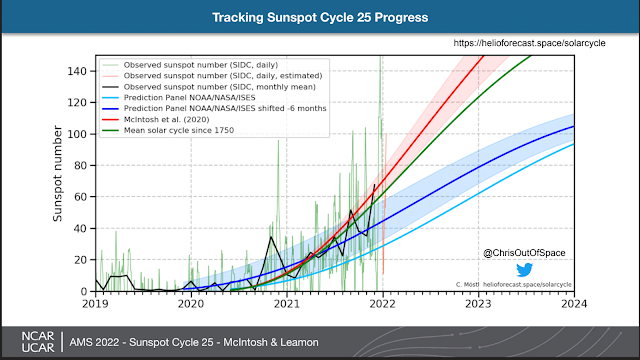Since the last solar cycle update I posted a month ago, interesting data continues to come in. The questions aren't being resolved, but the best thing I can say about it is that these guys are practicing real science. They post their predictions and their data, essentially saying, "show me where I'm wrong" and try to improve their methods. It's a sure sign there's no money it, compared to climate science or the Covid policy bosses.
In that post (among others), I've mentioned Dr. Scott McIntosh, the leader of
a group that has been predicting cycle 25 will be rather active. I came
across this plot two weeks later, around the end of January. You'll note
he's one of the authors of the talk this plot comes from.
It's a busy graph but the first the key feature to note is the black zigzag line, which is the observed monthly mean sunspot number. It's based on the rather light green very jiggly line - the raw daily sunspot numbers. After that, note the light blue band with the dark blue line it; the band is the NOAA - NASA prediction for cycle 25. The median of the predictions in that band and shifted earlier in time six months is the dark blue line. The red lines/band are McIntosh's. The dark green line is the mean of every solar cycle since 1750. It appears the observed cycle 25 sunspot numbers are looking more like the upper end of the NOAA/NASA predictions or maybe into McIntosh's. The last few months' peak to peak variation of the black curve looks like it's quite a bit higher than the blue band. Cycle 25 is looking pretty good.
A few days later, I ran into this plot which has a very different feel to
it. This is from
Space Weather News, a site affiliated with the Suspicious 0bservers channel we talked about
last week.
Now look closely at the bottom left corner. See that light gray line that's just barely above the light purple line? It's not above it all the time; sometimes it's the same level. That gray line is cycle 25 and the purple line is 24, the previous cycle, known to be the weakest cycle in a hundred years.
Cycle 25 isn't looking so hot is it? Yes, it's looking a teeny bit better than the last cycle, but that's just not saying much. It's the second weakest cycle since 1976 and is far less active than '76's cycle 21. Remember, cycle 24 wasn't just weaker than cycles 21-23, it was the weakest since 1913.
Finally, an interesting story in the American Radio Relay League's weekly
propagation report by Tad Cook, K7RA, dated February 7th. Tad covers a comment by Dr. Ron
Turner of ANSER Research Institute in Virginia, via Spaceweather.com. Dr.
Turner thinks it may be too early to expect a strong Solar Cycle 25 based on
the early the measurements we have so far.
"Solar Cycle 25 is doing something interesting. It is mimicking old Solar Cycle 24 (SC24).
"I took sunspot numbers from the early years of SC24 (the red dashed line) and overlaid them on SC25," says Turner. "They're an almost perfect match."
"This is significant because Solar Cycle 24 went on to become the weakest solar cycle in a century. Its hot start did not lead to a strong maximum. Turner isn't saying that Solar Cycle 25 will likewise be a dud. But, rather, "these early sunspot numbers are not enough to guarantee a strong cycle."
What's it going to be? Clearly nobody knows. Scott McIntosh's group's prediction is still the outlier with virtually all the other predictions closer to saying 25 will be most similar to 24, not one of the strongest, and solar activity well below the mean of every sunspot cycle since 1750.
I'd like to see the solar activity higher than 24, and that simply doesn't seem to be asking much. "It doesn't have to equal the strongest, just be stronger than the weakest cycle in a hundred years."



It'll be whatever Mother Nature decrees it to be. That's the limit of my "forecasting". Been following the Sun since 1963, and the only consistent thing I've seen about these forecasts is that they're consistently wrong.
ReplyDeleteThe bands were wide open today. Heard and worked stations 20, 17, 15, 12 ( ! ), and 10. Good signals, fairly stable with minimum QSB, and the noise level was low most of the time.
Vey informative.
ReplyDeleteThank you.
Earth lasers' plasma shield not only can dissolve storms (Univ. of Geneva), but it CAN prevent a devastating global blackout/all nuclear plants' blasting by asteroid explosion (as in Tunguska-1908 & Chelyabinsk-2013) or a solar storm hit! TEN times near-miss extinction so far: 1972, 1989, 1991, 2003, 2006, 2012, 2017, 2019, 2020, 2021, 2022 https://GlobalBlackoutPrevention.wordpress.com
ReplyDeleteConsidering there's pretty solid evidence that solar cycles and global temperatures are 'connected', we'd better hope for a heavy 25.
ReplyDeleteHate to start hearing about global cooling 'oh God we're all gonna die in 10yrs'.
If some of those folks were standing armpit deep in snow - in Phoenix - they'd still be screaming "we're all gonna die in 10 years." It's not about climate change, it's about control.
DeletePetty tyrants gonna tyrant.